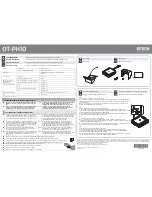
DIS-200G Series Gigabit Ethernet Switch CLI Reference Guide
190
35.
Surveillance VLAN Commands
35-1
surveillance vlan
This command is used to enable the global surveillance VLAN state and configure the surveillance VLAN. Use
the
no
form of this command to disable the surveillance VLAN state.
surveillance vlan
VLAN-ID
no surveillance vlan
Parameters
VLAN-ID
Specifies the ID of the surveillance VLAN. The range is from 2 to
4094.
Default
By default, this option is disabled.
Command Mode
Global Configuration Mode.
Command Default Level
Level: 15.
Usage Guideline
This command is used to enable the global surveillance VLAN function and to specify the surveillance VLAN
on the Switch. The Switch has only one Surveillance VLAN. This surveillance VLAN also supports to recognize
the surveillance devices, like IP Cameras (IPC) and Network Video Recorders (NVR), using the ONVIF
protocol.
Both the
surveillance vlan
command in the Global Configuration Mode and the
surveillance vlan
enable
command in the Interface Configuration Mode need to be enabled for a port to start the
surveillance VLAN
function.
When surveillance VLAN is enabled for a port, the port will automatically be learned as a surveillance VLAN
untagged member. Received untagged surveillance packets will be forwarded in surveillance VLAN. Received
packets are determined as surveillance packets if the source MAC addresses of packets comply with the OUI
addresses configured by the
surveillance vlan mac-address
command.
An auto-surveillance VLAN can also be used to carry video traffic from an IP camera and its related
components like Video Management Servers (VMS), VMS clients, and video encoders. These devices can be
recognized by an OUI address and the ONVIF protocol. If the IPC is recognized by the ONVIF protocol, the
Switch will learn the IPC on a port by snooping Hello/ProbeMatch packets and then insert the port into the
surveillance VLAN. The Switch regards a host as an NVR once it connects to the IPC via HTTP, HTTPS or
RTSP. The Switch will learn the NVR on this port and insert it into the surveillance VLAN.
If the IPC is recognized by OUI address, the Switch will determine whether a received packet is a video packet
or not by checking its IPC MAC address. If the source MAC addresses of the untagged packets has the same
MAC address as the IPC. These packets are determined as video packets and transmitted in surveillance
VLANs. If the incoming video packet is tagged, and its VLAN ID is equal to the surveillance VLAN, the priority
of the packet will be remarked with video traffic priority.
When the IPC is recognized by its OUI address and ONVIF protocol at the same time, this IPC will be
recognized by the ONVIF protocol and take action. If the resource supported ONVIF device is depleted, the
IPC will be recognized by OUI address.
The VLAN to be specified as a surveillance VLAN needs to pre-exist to use this command.
If the surveillance VLAN is configured, then the surveillance VLAN by the
vlan
command cannot be removed.
















































